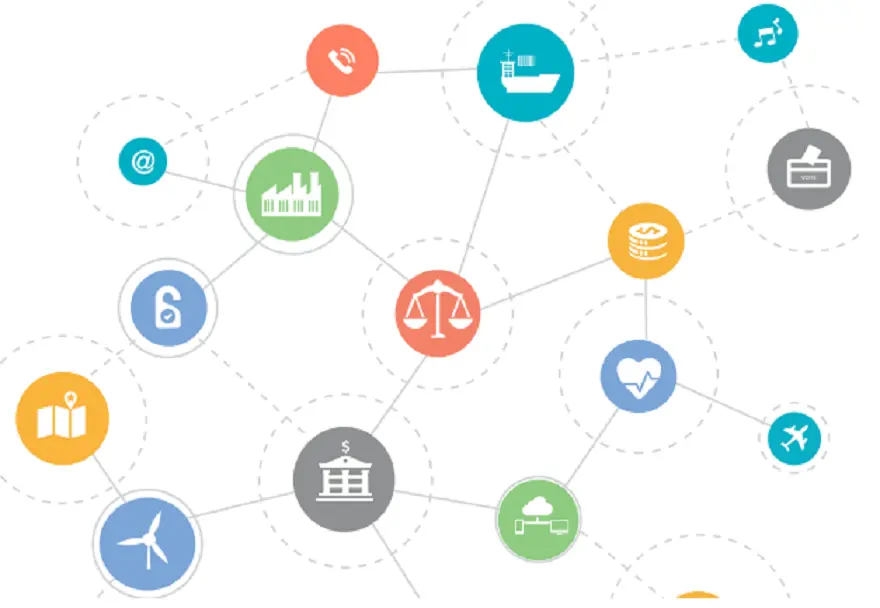What Is a Distributed Ledger?
A distributed ledger is basically a database where transactions and transaction details are stored and distributed across the nodes of a network. Therefore, the verification of data added to the ledger, as well as any update made to the said ledger, is not administered by a central entity, nor is the information stored on a central cloud or data storage system like traditional storage systems. Instead, the many participants on the network are required to reach a consensus in order to validate the updated distributed ledger, as well as own a copy of it.
What Is the History of Ledgers?
The concept of a ledger, which is primarily meant to serve as a record for transactions, has been in existence for millennia. At one point, transactions and the transfer of properties were recorded on clay, wooden tally sticks, stones, and papyrus. The process of recording transactions progressed further with the invention of paper. The normalization of computers in the 80s and 90s led to the digitization of ledgers.
However, the new concept discussed here has been able to stretch the limits of the previous ledger definition. Although we still live in a paper-based society—which is evident in our reliance on paper bills, seals, certificates, and written signatures—digital ledgers are becoming more and more the norm. Basically, digitized ledgers serve as the medium to transfer paper ledgers, and they are subject to central authorities.
The advent of 21st-century technology innovation has introduced optimized ledgers that are distributed and nearly impossible to hack or manipulate, thanks to state-of-the-art cryptographic protection mechanisms.
How Does Distributed Ledger Technology (DLT) Work?
As previously mentioned, a distributed ledger is a database that is updated and maintained by each participant on the network, i.e. node. Unlike a traditional database, records are independently processed and stored by each network node. As such, each node has input in the transaction validation process, as they are required to vote in order to reach a conclusion on the validity of the transaction. This validation process is called consensus, and a majority of the network’s users will have to agree on a conclusion before consensus can be reached.
After the network agrees that a transaction is valid, the database will be updated, and each user will keep a copy of the updated ledger. This structure makes the distributed ledger technology a more sophisticated form of database as it eliminates the need to trust a third party or a central figure. As a result, this technology is commonly referred to as a trustless mechanism.
There are various consensus mechanisms suitable for distributed ledgers, each with its pros and cons. However, they all serve the purpose of establishing consensus in a network, albeit with different methodologies. These consensus processes or mechanisms generally follow these four steps:
- Each node constructs the data or transactions it wants to add to the ledger.
- The constructed data is distributed to all the nodes of the network.
- The nodes reach a decision on the validity of the transactions.
- Each node updates its distributed ledger once a conclusion is reached, which will reflect the result of the consensus.
However, the speed at which each step is completed determines the efficacy of the consensus mechanism adopted in the ledger.
What Is a Consensus Protocol and Algorithm?
Consensus protocols are a set of rules governing the functionalities of a consensus-based system, while a consensus algorithm is a rule that specifically governs the process of achieving consensus. In other words, an algorithm governs the order of the steps as well as the necessary conditions for a successful output of a consensus system in, for example, a distributed ledger. Consensus algorithms are generally scripts or complex programs.
What Is Cryptography?
Cryptography has been around for a while now—there’s proof that this encryption method was utilized in ancient Egypt and even in the Roman era. Cryptography basically is a process of encrypting sensitive data.
Thousands of years after this concept was introduced, it’s playing a big role in the actualization of distributed ledgers. Once data is recorded, it is encrypted by state-of-the-art cryptography, which secures the data from potential cyber-attacks and financial fraud. Users are only able to access this data with keys and cryptographic signatures.
What Are the Potential Uses of the Distributed Ledger Technology?
Distributed ledger technology has continuously shown its disruptive force in the financial sector as it is gradually changing the way we perform and record transactions. Yet, the technology is believed to be able to revolutionize other critical sectors. Therefore, there are lots of ongoing studies that are testing the limits of this technology. According to the World Bank, this technology “has the potential to transform various other sectors as well, like manufacturing, governments’ financial management systems, and clean energy.” Other potential uses of this technology in different industries include the following:
- DLT has the potential to create transparent and more secure fundraising for charity organizations.
- It can also optimize existing voting systems, which will ensure that votes are not susceptible to manipulations.
- Its functionalities can enhance and optimize supply chain trackers for various commodities.
- It can serve as a trustless and tamper-free land registry database.
- It is suitable for cloud computing and storage systems.
- In addition, this technology can power a more efficient medical database that will improve the healthcare industry.
- The legal sector is also looking for ways distributed ledgers could function as a major tool to store legal documents.
- It can effectively optimize intellectual property systems.
- This technology can potentially be used in storing and verifying identities.
Benefits of Distributed Ledgers
The above list of the potential applications of DLT proves that the technology can revolutionize the way we live as it can maintain information in decentralized form across different locations and people.
At the moment, distributed ledger technology is transforming the financial sector, as well as the global remittance economy. As a result, there has been an emergence of digital assets or virtual currencies that can guarantee users’ privacy, irrevocable transactions, decentralization, and inflation-free systems.
In addition, a huge value of this technology lies in its potential to play a vital role in other sectors, like the food supply chain, intellectual property, logistics, energy, and the legal sector. With the help of this technology, we are able to correct the major flaws of traditional systems in these areas.
Why Are Distributed Ledgers Important?
The distributed ledger has functionalities that make it unique and effective. One such functionality is the distributed nature of the ledger. Unlike traditional database systems, it gives total control of the ledger’s operations to the network’s participants. Therefore, it is very unlikely that the data on the ledger can be compromised or manipulated, as attackers have to simultaneously hack the entire distributed copy of the ledger.
In addition, a distributed database eliminates the need for banks or middlemen, as users can perform transactions directly. Therefore, it is possible for users to perform instant and cheap transactions. Also, the distributed nature of the ledger means that the system grants complete transparency.
What Is a Blockchain Ledger?
A blockchain ledger is a distributed ledger where data is entered into blocks that are then linked within a growing chain of more blocks. The ledger is distributed across a peer-to-peer network, as such, the technology is able to bypass the need for a central authority. This technology is the major driving force for cryptocurrencies like Bitcoin.
Types of Distributed Ledgers
The three major types of distributed ledgers are private, public, and consortium distributed ledgers. A public distributed ledger allows anyone to participate in the input of data or transactions and the verification process. In contrast, a private DLT is restricted to trusted nodes; therefore, only permitted members can access these ledgers. The consortium distributed ledger is a hybrid of the private and public ones. As such, a consortium or a group of institutions serves as the node of the network and the content on the ledger may or may not be made public.
Distributed Ledger vs Blockchain
There have been lots of misconceptions over the difference between a distributed ledger and a blockchain. A blockchain is simply an implementation of distributed ledger technology. A blockchain utilizes the distributed database concept to ensure that the system stays decentralized.
However, you should note that not all distributed ledgers are blockchains. This is because not all distributed databases utilize the block structure found on the blockchain. To better grasp the difference between these two terms, we need to clarify the difference between a distributed ledger and a decentralized ledger.
Distributed vs Decentralized Ledger
Distributed and decentralized ledgers are a bit similar as both systems distribute the database to all the participating nodes of the network. Decentralized ledgers, however, allow all the nodes to participate in the running of the network. Therefore, decentralized ledgers completely eliminate all central entities, and the network involves every node in the transaction verification process. As a result, this type of ledger is suitable for public and permissionless blockchains like the Bitcoin blockchain.
A distributed ledger, in contrast, does not necessarily support a fully decentralized system. Although all nodes get a copy of the ledger, the final decisions on the functions and the validity of the ledger could still be part of a central system. Consequently, the majority of private blockchains and even consortium DLTs are ledgers that do not fully comply with the concept of decentralization.
What Is a Crypto Ledger?
The blockchain is popularly known as the underlying technology supporting digital currencies or cryptocurrencies. Therefore, blockchain-based crypto networks, which are also known as crypto ledgers, are platforms where users can use digital currencies to perform instant transactions. The ledger utilizes cryptography to ensure transaction security. In addition, each ledger comes with a consensus mechanism that governs the cryptocurrency’s verification process in relation to its transactions and its mining procedures.
What Is the Bitcoin Ledger?
Bitcoin was the first digital currency to utilize blockchain technology, and it remains the most valuable cryptocurrency on the crypto market. This ledger has a proof-of-work mechanism that requires users to come up with solutions to complex computer puzzles before new blocks of transactions can be added to the blockchain. When a user successfully completes these tasks, the network rewards them with a specific amount of Bitcoin; therefore, the process is called Bitcoin mining.
Since the blockchain is the underlying technology behind the Bitcoin ledger, the Bitcoin network is decentralized, and the network is a hack-free and tamper-free ledger. Also, the ledger allows users to make instant payments and transactions with reduced charges, as the network is free from the input of middlemen or central figures.
Another feature of the Bitcoin blockchain is the availability of a cryptographic system that requires users to use keys to access anything recorded on the blockchain.
The Distributed Ledger and Business Enterprises
As for distributed ledger technology, businesses around the world are starting to incorporate it. The potential of this technology has led to its explosive growth and a good deal of institutional adoption. We presently have many consortium-distributed databases that are powered by groups of firms looking to use the technology to resolve specific issues. One example is the Corda DLT, which is a product of the R3 consortium. The consortium is comprised of over 200 firms, and it is specially designed to facilitate instant cross-border payments. Some of the companies supporting this project include Barclays Bank, Citibank, and UBS.
The applications are pretty much limitless. One can argue that this technology can be used for any online-based business. We are seeing the rise of Bitcoin credit unions, Bitcoin crowdfunds, and even some gambling platforms that accept Bitcoin payments have started implementing the technology.
Another distributed ledger initiative that we can call a consortium DLT is B3i. A total of 13 firms founded the consortium, and the blockchain project focuses on the use of the distributed ledger to optimize the insurance industry. Also, the Hyperledger initiative, which the Linux Foundation hosts, is supported by over 250 companies. Some of the companies that independently own DLT projects include Goldman Sachs, JP Morgan, IBM, Microsoft, Amazon, and Google.
The Distributed Ledger’s Future
Because it’s still a burgeoning concept, DLT implementation is still in its early stages. As expected, many believe that the technology will likely infringe on privacy regulations like the newly introduced GDPR. However, others have argued that the blockchain is more privacy-conscious than traditional database systems. In addition, there is a possibility that AI will be integrated into distributed ledgers in order to create fully automated ledger technologies. It is safe to say that we have only been able to witness a glimpse of the potential opportunities that come with systems utilizing the distributed ledger.









